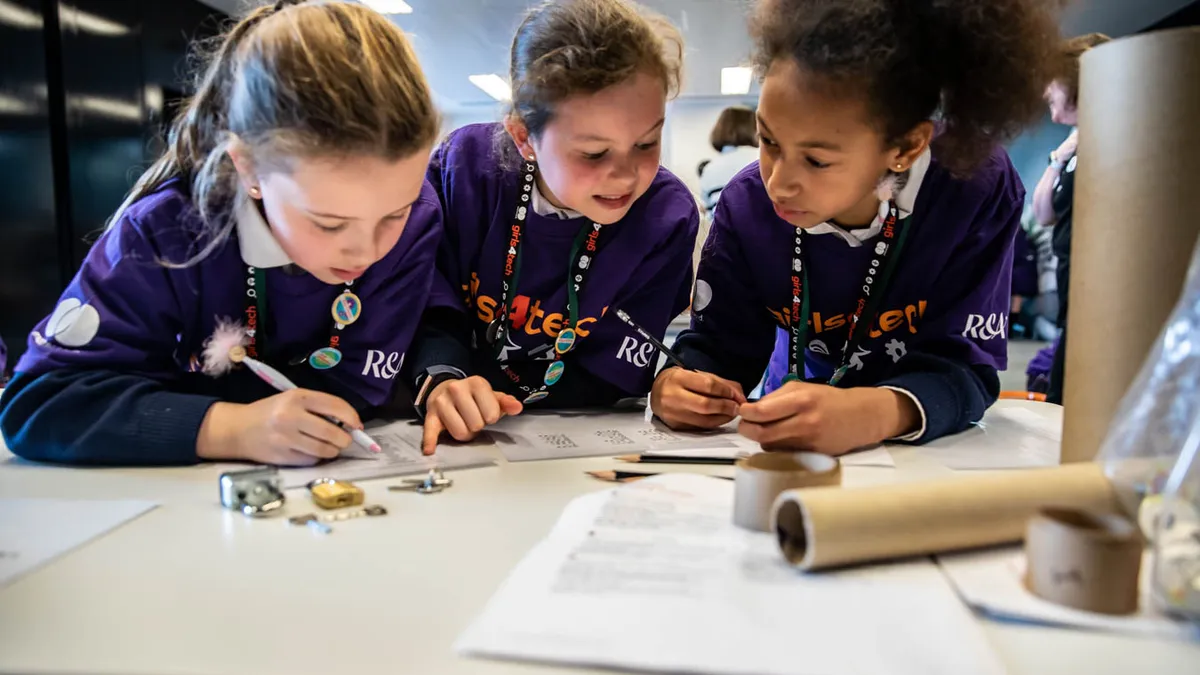At the end of her freshman year of high school, Beatrice Karp and her team proposed an idea.
It was for an app, built around fashion, which would generate ideas for outfits based on the occasion or the weather.
"That was the first time I ever thought of coding as a solution and that's really what it's used for today," Karp told CIO Dive.
Four years ago, Karp's start with coding lacked dark screens and endless line of code. Rather, she used block-based visuals in the Scratch programming language.
Scratch captured the fundamentals using drag-and-drop functions, freeing users from rules dictating tabs or spaces and concern over runtime errors.
Karp's introduction to STEM came through Mastercard's Girls4Tech education program. It is one of many education programs in the U.S. and around the world, designed to promote interest in STEM when girls are in middle- or early high school. Interest dwindles if introductions to the field are made too late.
Women choosing technology careers face a sector with a woeful lack of diversity. Women account for 47% of the U.S. workforce, yet only 25% of IT workers are women, according to IDC analysis in partnership with Women in Technology International. Just 18% of computer science graduates are women.
"We want to change [young women's] perception and their thought processes around what STEM is and what a technology curriculum is."

Dana Lorberg
EVP of Network Technology at Mastercard
With a glaring skills gap and demand for technology workers outweighing supply, programs are working to foster technology interest early on to bolster the pipeline.
It worked for Karp. She was one of the 400,000 girls who went through the program, now celebrating its fifth anniversary. "It taught us how to tackle an issue and use tech to approach that, which I still do all the time with my academics," Karp said.
Girls4Tech changed Karp's trajectory, and four years later, about to finish her freshman year at the University of Pennsylvania as a midshipman in the Naval ROTC program and a member of the school's ski team, her future includes STEM.
The economics of diversity
Promoting interest in technology for underrepresented populations is not about filling seats at empty desks. There's an economic imperative.
It's "better business to have diversity," said Dana Lorberg, EVP of Network Technology at Mastercard, in an interview with CIO Dive.
Companies ranked in the top 25% for gender diversity on executive teams are 21% more likely to have "above-average profitability" than companies in the lowest quarter, according to McKinsey research. Leading teams also outperform peers on long-term value creation.
The research found there is also a penalty for lacking gender and ethnic diversity. Those companies in the lowest quartile are more likely to be less profitable than industry peers.
"When you have diversity in gender, when you have diversity from an ethnic and cultural perspective … you get different lived experiences, different perspectives and you actually build better products," said Sharon Kennedy-Vickers, CIO, director of technology and communications at the City of Saint Paul. She is also the cofounder of TECHQUITY, a group working to increase the visibility of African Americans in tech.
"You don't fall into the perils and pitfalls of how data and technology can be used to reinstitute biases and discrimination," she told CIO Dive.
"When you have diversity in gender, when you have diversity from an ethnic and cultural perspective … you get different lived experiences, different perspectives and you actually build better products."

Sharon Kennedy-Vickers
CIO, director of technology and communications at the City of Saint Paul
In a male-dominated field like technology, long-standing norms run deep. It is difficult for women to imagine what they cannot see.
Introducing more women to technology is a "crisis on the planet for us to be focusing on and making a generational change," said Lorberg.
Lorberg was in high school when a computer was wheeled into the classroom. It clicked with her and she pursued a career as a computer programmer, which has led to 32 years at Mastercard and later, her involvement in Girls4Tech.
"We want to change [young women's] perception and their thought processes around what STEM is and what a technology curriculum is," she said.
A long way to go
Women's overall participation has remained stagnant. In 2015, women held one-quarter of computing occupations, a number which holds steady today.
"In the 40 years I've been part of industry, I have not really seen an increase at all in my fellow workers of female to male ratio at all. None," said Celeste Fralick, chief data scientist and sr. principal engineer at McAfee, in an interview with CIO Dive. "And it saddens me."
But the experience in the tech workforce has improved for women.
"As I started in the industry, there were still calendars with naked women on them" in the office, said Fralick.
"In the 40 years I've been part of industry, I have not really seen an increase at all in my fellow workers of female to male ratio at all. None."

Celeste Fralick
Chief data scientist and sr. principal engineer at McAfee
In an era dominated by the #MeToo movement and a spotlight shown on employee treatment, women are speaking up in the workplace, demanding equality.
Grassroots movements encourage change, but companies require top-down leadership to drive improvements.
"Companies, organizations and leaders have to be intentional about diversity," said Kennedy-Vickers.
"Will it be a challenge for us to do? Will it require work on our part to that? Yes it will," she said. "Can it be done? I believe so by being intentional about it and talking about that value and a diverse workforce and team adds."




















